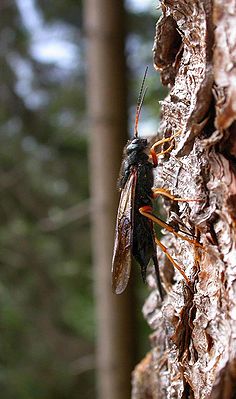Common wood wasp
| Common wood wasp | ||||||||||||
|---|---|---|---|---|---|---|---|---|---|---|---|---|

Common wood wasp ( Sirex juvencus ) ♀ |
||||||||||||
| Systematics | ||||||||||||
|
||||||||||||
| Scientific name | ||||||||||||
| Sirex juvencus | ||||||||||||
| ( Linnaeus , 1758) |
The common wood wasp ( Sirex juvencus ), also known as the pine wood wasp , is a representative of the wood wasp family that is widespread worldwide .
distribution and habitat
The common wood wasp occurs in Europe , Japan , Australia , North America (up to Labrador and Newfoundland ). It occurs mainly in pine forests, rarely also in spruce stands.
description
The common wood wasp grows 15 to 30 millimeters in size. Her body is blue-black. In the antennae of the females, apart from the base limb, the first five limbs are rust-colored, the following ten blackish. The males have a red and gold ring on their abdomen.
Reproduction
The females seek out a freshly felled, sick or injured tree to lay their eggs. Dried out or built-in wood is not used. With the help of their laying spines, they lay 8 to 10 eggs under the bark, together with spores of the brown felted layer fungus ( Amylostereum areolatum ). The total production includes several hundred eggs. The larvae are white and eyeless. They have stumpy legs on the chest, but no stomach feet. They feed on the mycelium of the fungus and drill tunnels in the wood, which they later fill up with sawdust. These feeding tunnels can be up to 40 centimeters long and have a diameter between 4 and 7 millimeters. To pupate, they dig a small chamber just under the bark, the so-called “pupa cradle”. The exit holes of the hatching wasps have a diameter between 4 and 10 millimeters. Development takes three to six years.
food
The food of the larvae in the feeding tunnels consists of wood which has been broken down into white rot by the many fungal hyphae.
Economic damage
The damage caused remains relatively minor, since heavily infected wood is sorted out during processing and wood that has already dried is not used for laying eggs.
However, it can happen that hatching wasps gnaw through materials (carpets, linoleum and even roofing felt) and cause damage.
literature
- Helgard Reichholf-Riehm, Gunter Steinbach : Insects with appendix arachnids 1984, Mosaik Verlag, Munich, ISBN 3-570-01187-9